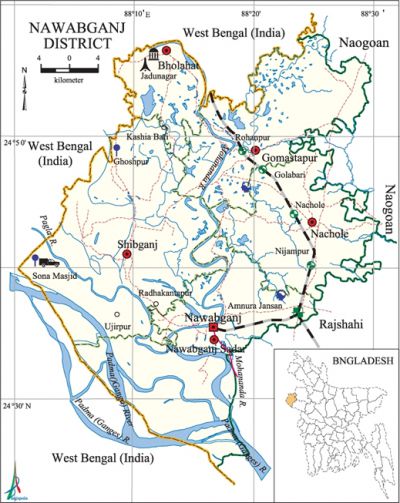Nawabganj District
Nawabganj District (rajshahi division) area 1702.56 sq km, located in between 24°25' and 24°58' north latitudes and in between 88°01' and 88°30' east longitudes. It is bounded by west bengal state of India on the north, south and west, rajshahi and naogaon districts on the east. The district is comprised of barind tract, diara and char lands.
Population Total 1425322; male 725354, female 699968; Muslim 1356524, Hindu 60809, Buddhist 4493, Christian 98 and others 3398. Indigenous communities such as oraon, santal, Mahali, Murari, Pahan belong to this upazila.
Water bodies Main rivers: padma, mahananda, Pagla.
Administration Until 1947, Nawabganj was a thana under the district of Maldah (India). At the time of the partition of Bengal it was upgraded to a Sub-division under Rajshahi district. It was turned into a district in 1984. Of the five upazilas of the district shibganj is the largest (525.43 sq km, it occupies 30.86% of the total area of the district) and bholahat is the smallest (123.52 sq km).
| District | |||||||||
| Area (sq km) | Upazila | Municipality | Union | Mouza | Village | Population | Density (per sq km) | Literacy rate (%) | |
| Urban | Rural | ||||||||
| 1702.56 | 5 | 3 | 45 | 785 | 1120 | 269087 | 1156235 | 837 | 35.9 |
| Others Information of District | ||||||||
| Name of upazila | Area (sq km) | Municipality | Union | Mouza | Village | Population | Density (per sq km) | Literacy rate (%) |
| Gomastapur | 318.13 | 1 | 8 | 166 | 227 | 240123 | 755 | 35.4 |
| Nawabganj Sadar | 451.80 | 1 | 14 | 174 | 211 | 452650 | 1002 | 38.1 |
| Nachole | 283.68 | - | 4 | 201 | 197 | 132308 | 466 | 40.3 |
| Bholahat | 123.52 | - | 4 | 45 | 93 | 92149 | 746 | 39.2 |
| Shibganj | 525.43 | 1 | 15 | 199 | 392 | 508092 | 96732.5 | |
Source Bangladesh Population Census 2001,Bangladesh Bureau of Statistics.

History of the War of Liberation On 6 October 1971, a battle was fought between the freedom fighters and the Pak army at Shikarpur of Kansat union in which about 200 freedom fighters were killed. On 10 October 1971, the Pak army brutally killed 47 persons of villages Dorashia, Mollatola, Lampat and Radhakantapur of Shibganj upazila. On 16 October, one freedom fighter was killed in an encounter with the Pak army at Kashiabari of Bholahat upazila. On 14 December an encounter was held between the freedom fighters and the Pak army at Rehaichar of Nawabganj Sadar in which Birsrestha mahiuddin jahangir was killed.
Marks of the War of Liberation Mass grave 3 (Jambariagram, Baliadighi Paschimpar, Fakirpara in Gomastapur), mass killing site 2 (Sathia Bazar and Jadunagar), memorial monument 1 (Nawabganj Government College), martyrs' memorial 2 (main gate of Bangladesh Rifles, Nawabganj municipality compound), memorial plate 2 (premises of Chatrajitpur High School and Shibganj), Birsrestha Mahiuddin Jahangir bridge (1993).
Literacy rate and educational institutions Average literacy 35.9%; male 37.4%, female 34.4%. Noted educational institutions: Adina Fazlul Haque College (1938), Nawabganj Government College (1955), Nawabganj Government Mohila College (1966), Rohanpur Yeasuf Ali College (1967), Kansat Soleman Degree College (1968), Nachole Degree College (1972), Bholahat Mohebullah Degree College (1986), Gomastapur Soleman Mia College, Shah Niamatullah college, Harimohan Government High School (1895), Kansat High School (1917), Dadanchal HM High School (1919), Nachole Pilot High School (1957), Bholahat Rameshwar Pilot High School (1911), Nayanabhanga Government Primary School (1870), Chadlai Government Primary School (1919), Nachole Primary School, Nawabganj Alia Kamil Madrasa (1964), Chatrajitpur Senior Madrasa (1944), Radhakantapur Senior Madrasa (1950).
Main sources of income Agriculture 57.13%, non-agricultural labourer 5.16%, industry 1.35%, commerce 17.05%, transport and communication 1.76%, service 4.64%, construction 2.90%, religious service 0.17%, rent and remittance 0.69% and others 9.15%.
Newspapers and periodicals Weekly: Chapai Sangbad, Gaur Sangbad, Simanta Kagaj, Mahananda, Gaur Bani, Purbarag, Kathkhor, Ashani, Muktakantha, Pagla, Pattaya (defunct), Falguni (1960), Alor Pathe (1962); periodical: Nawabganj (1964), Mahananda (1978), Darpan (1994), Protibha Bikash, Rohanpur Barta.
Folk culture Gambhira, Kavigan, Alkapgan, Meyeli geet, rhymes, Upakatha, riddle, etc. [Mazharul Islam Taru]
See also The upazilas under this district.
References Bangladesh Population Census 2001, Bangladesh Bureau of Statistics; Cultural survey report of Nawabganj District 2007; Cultural survey report of upazilas of Nawabganj District 2007.
